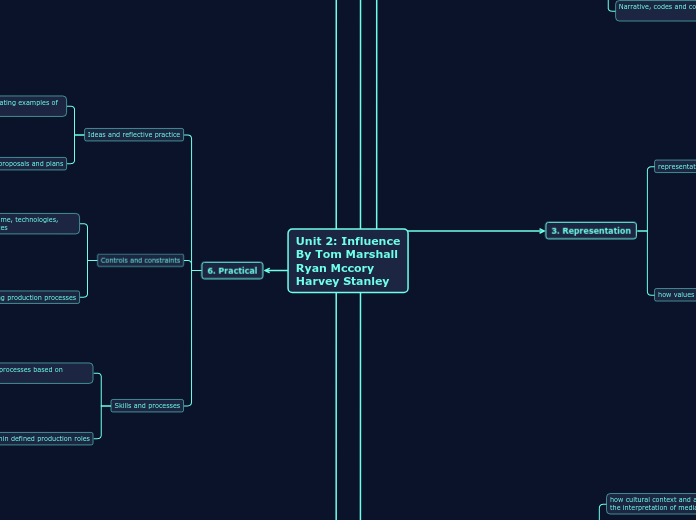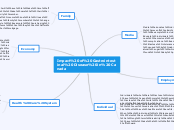Unit 2: Influence
By Tom Marshall
Ryan Mccory
Harvey Stanley
Industry
Media producers
the potential freedom of independent media producers
Analysis of the opportunities and challenges faced by independent media producers in expressing their unique perspectives and ideas.
Exploration of media conglomerates and their influence on the industry
the impact of concentrated media ownership
Understanding the economic factors at play in the media industry, including advertising revenue, subscriptions, and market competition.
The influence of concentrated media ownership on the control and shaping of media content, narratives, and agendas.
Production contexts
ethical issues, accuracy of information and legal consequences
Exploration of industry guidelines, codes of conduct, and regulatory frameworks that aim to ensure ethical practices within the media industry.
Exploration of the different stages and aspects of media production, such as pre-production, production, and post-production.
how production contexts influence the point of view of media work
The role of regulations, laws, and industry standards in shaping the production and content of media work.
How funding models, advertising, and revenue streams shape the content and perspectives presented in media.
Practical
Skills and processes
refining skills within defined production roles
Discussion of the different roles within media production, such as director, producer, cinematographer, editor, sound designer, etc.
Exploration of the technical limitations and requirements in various media production formats, such as film, television, or digital media.
implementing production processes based on proposals and plans
Understanding the legal and ethical frameworks that govern media production, including copyright, intellectual property, privacy, and ethical standards.
Exploration of the technical limitations and requirements in media production, such as equipment, software, and production techniques.
Controls and constraints
negotiating and adapting production processes
Analysis of the collaborative nature of media production and the negotiation of roles, responsibilities, and creative decisions among team members.
Examination of legal, ethical, and regulatory frameworks that impose controls and constraints on media production, such as content guidelines, copyright laws, and industry standards.
ndependent management of time, technologies, safety procedures and resources
Analysis of the practical considerations and challenges faced by media practitioners in managing their time effectively during production.
Exploration of legal and ethical constraints that impact media production, such as content regulations, censorship, and copyright laws.
Ideas and reflective practice
developing proposals and plans
Consideration of budgeting, resource allocation, and scheduling in project planning.
The importance of generating creative ideas and concepts for media projects.
investigating, analysing and evaluating examples of media work
Engaging in critical analysis of existing media works to understand their techniques, strategies, and impact on audiences.
The utilization of theoretical frameworks and concepts in the practical process of media production.
Media examples
Influential media works
Tom
The media work I have chosen that is very influential and persuades the audience is South Park.
South Park is known for its satirical commentary on real-life events. The show’s creators, Trey Parker and Matt Stone, use the show’s characters as thinly veiled metaphors for “ripped from the headlines” storytelling. South Park Studio’s use of computer animation allows it to edit episodes in days, quickly commenting on recent events.
documentaries
using codes and conventions to convey theme, genre, style and narrative
Analysis of the codes and conventions used in documentary filmmaking to convey themes, genre, style, and narrative.
Exploration of how documentaries serve as a medium for presenting real-world stories, events, and issues.
producing purposeful and/or influential content
Examination of documentaries that tackle social, political, or environmental issues with the aim of raising awareness and inciting change.
Exploration of various techniques employed in documentary filmmaking, such as interviews, observational footage, archival materials, and reenactments.
Australian news media and journalism
Journalism students learn to choose their words carefully and understand their full impact
Analysis of the responsibility journalists have in choosing their words carefully and understanding their full impact on audiences.
Exploration of ethical guidelines and codes of conduct that govern Australian news media organizations and journalists.
ncompasses subdisciplines that focus on how the public gains access to information
Discussion of subdisciplines within media studies, such as media law, media ethics, and media literacy, that address how the public gains access to information.
Exploration of the role of Australian news media and journalism in providing information, shaping public opinion, and promoting democratic discourse.
Audience
the interrelationship between producers and audiences
- Add the syllabus points to the mind map, in the correct positions
Media producers define and categorise their audience through demographic profiles
The shift towards a participatory culture where audiences are active participants in content creation and distribution.
The ways in which media producers actively seek and respond to audience feedback, opinions, and preferences.
use audience research and analysis to find out as much as possible about their target audience
The use of audience research and analysis to understand the demographics, preferences, and behaviors of the target audience.
The importance of fostering a two-way communication channel between producers and audiences.
how cultural context and audience values influence the interpretation of media work
Affects the way we communicate as the viewer or sender.
The ways in which audiences actively engage with media content, including discussions, debates, and social media interactions.
The impact of cultural background, beliefs, and values on how audiences interpret and understand media content.
process of interpretation of media texts, cultural and historical factors influencing the viewpoints
The cognitive and psychological processes involved in interpreting media texts, such as encoding, decoding, and meaning-making.
The impact of cultural context on the interpretation of media work, considering factors such as language, customs, traditions, and societal norms.
Representation
how values shape representations
influences our views of experiences and ideas.
Understanding how media framing influences the perception and interpretation of events, issues, and individuals.
Exploration of how cultural values, beliefs, and ideologies shape the way media represents various groups, events, and phenomena.
Media texts have the power to shape an audience’s knowledge and understanding about topics
Media texts have the ability to influence and shape the audience's perception, knowledge, and understanding of various topics.
Media texts often reflect the values, beliefs, and ideologies of the creators and the society in which they are produced.
representation of groups, places, events and ideas
through language, structural and/or visual choices is an important skill
The impact of language choices in shaping representations and influencing audience interpretations.
The portrayal and depiction of different social, cultural, and demographic groups in media.
how media texts deal with and present gender, age, ethnicity, national and regional identity
Exploration of power dynamics within media representations, including the portrayal of marginalized groups.
Examination of how media texts depict and represent different genders, age groups, ethnicities, and national or regional identities.
Media Language
Narrative, codes and conventions
• codes and conventions to construct realism in journalistic or influential media work
Visual and audio cues (camera angles, sound design, editing) to create a sense of authenticity.
Use of documentary techniques, interviews, archival footage, observational style to enhance credibility.
• use of narrative in journalistic or influential media work
Role of characters, plot development, and conflict in conveying information or promoting ideas.
Storytelling techniques to engage and inform audiences.
System of communication
• audience reach, immediacy, accessibility and interaction
The availability and ease of access to media content.
The ability of media to reach a wide and diverse audience.
• media ownership, sources of revenue and expectations of particular media
Genre conventions. Audience expectations. Cultural and societal influences on media expectations
Advertising. Subscription models. Sponsorship and product placement. Public funding
Concentration of media ownership. Media conglomerates. Impact of ownership on content and perspectives
Verbal language. Visual language. Non-verbal communicatio.n Semiotics and signs in media









